You’re stuck, overwhelmed, and worried about your blog.
You started a blog with as much enthusiasm as a kid in a candy store and had about a million blog ideas in your head.
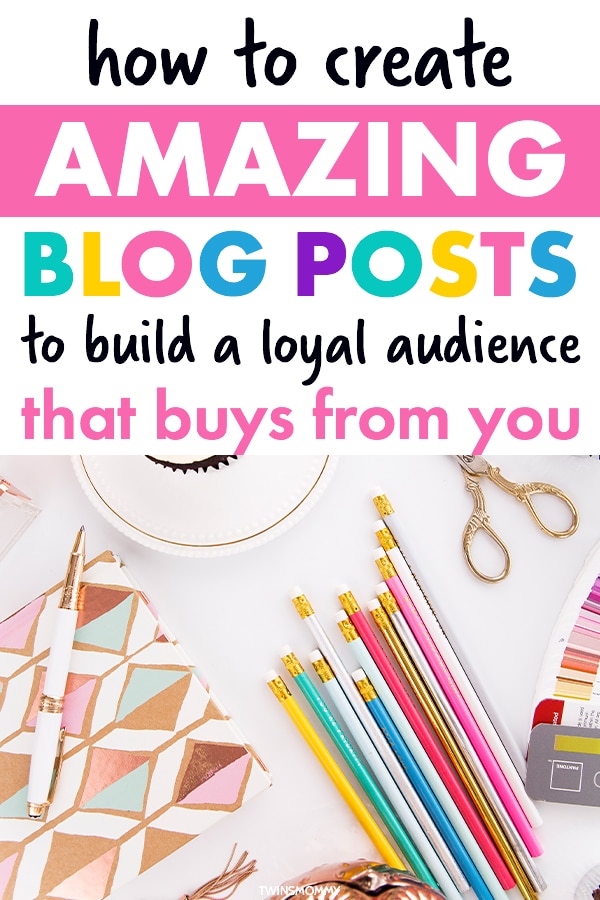
You wonder, how do you write a blog post template that’s amazing, helpful and isn’t like the thousands of other blog posts that I see on Pinterest?
My first blog post was…well…bland and read like a school paper than an informational blog post.
But, you know what? I loved it!
I loved blogging and I learned over time how to create a blog that people loved to read.
So, let’s go over some tips that can help you connect with your audience better, help you grow your traffic and make more sales!
Are you ready?
Blog Post Template
One of the first things I noticed when I started reading other people’s blogs was how they were formatting their blog post templates.
Many of them had very short paragraphs, they used lists, images and bolded key phrases.
I also noticed how they structured their blog posts and this helped me form my own way of writing a blog post.
Here is my blog post template.
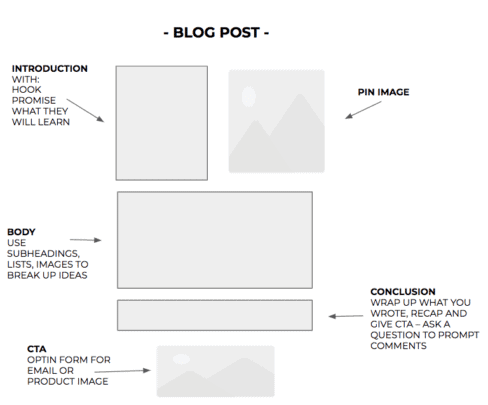
Let’s go over the format and then we can cover the actual writing to attract readers component!
1. Blog Post Template – Headline
Your headline is probably one of the most important pieces of copy in your entire blog post.
Why?
Because that is usually what people see on social media.
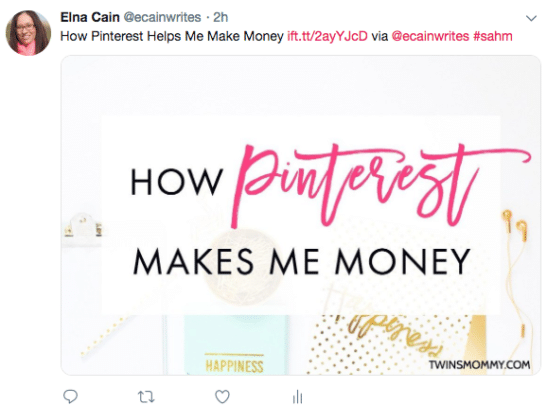
In a split second someone scrolling through Twitter or Pinterest or Instagram will see your headline and make a decision to stop and read or keep on scrolling.
Your headline can also help you rank in Google. You do this by optimizing your blog headline with keywords.
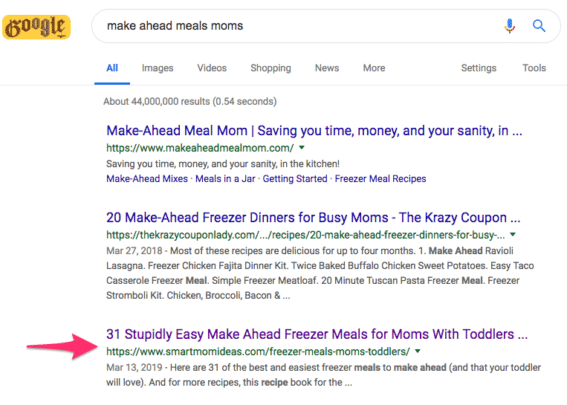
But, SEO is an entirely different mindset from writing a blog post as a new blogger.
I didn’t focus on SEO for the first year of Twins Mommy – but that didn’t stop me from ranking in Google.
If you want to learn more about using SEO (keywords in particular), check out my post on the first step to SEO.
Another thing about your headline is that you can have an entirely different headline for social media than what you have for your blog post.
So, if you feel your blog post headline isn’t doing it for you, you can:
- Change it (but not the URL, just the words in the title)
- Don’t change it and make a “new” one for your pin graphics or other social graphics
What makes a good headline?
- It’s emotional
- Benefit driven
- Helpful
- Can be a list headline
Some of the best headlines are list headlines that solve a problem:
- 22 Amazing Hacks to Get Your Newborn Sleeping Through the Night
- 107 Toddler Activities That Take Moms Minutes to Set Up
- 45 Beauty Secrets That Make You Look Posh as a Busy Mom
As you can see, all these headlines focus on a problem and how to fix that problem. I also like to “call out” the audience I’m attracting (moms, new moms, pregnant moms etc..).
Focus on those elements when writing your headlines.
2. Blog Post Template – Blog Introduction
The only part you need to know about your blog introduction is the first sentence.
If you can hook a reader in the FIRST sentence, they will read the second sentence.
And if they like the second sentence, the will read the third, and fourth and so on.
So, your goal as a new blogger is to hook your reader from the very first sentence.
As a copywriter, I learned that bucket brigades are a great way to start your blog post. Essentially, a bucket brigade is a partial thought or idea and it makes you HAVE to read the second sentence.
So, it would look like this:
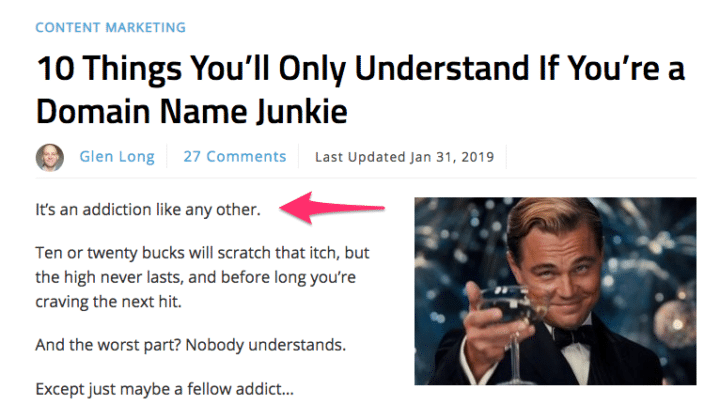
You read Glen’s first sentence and you have to read the second sentence. Glen does a great job to lead you down this introduction by “teasing” the reader and slowly unraveling his topic.
This process takes practice but, an easy “hack” is to ask a question. I often do this for my introductions. If I can get a reader to nod “yes” with me, then they are more likely to keep on reading.
So, try asking a question as your first sentence.
3. Blog Post Template – The Body of Your Blog Post
The body of your blog post is the “meat” of your entire blog post.
It’s why someone clicked over to read your content.
Now, there are two camps in regards to the body of your blog post:
- It’s long form and mentions “everything” about that topic
- It’s short, to the point, and answers the questions the blog post is trying to answer
If you want to write an amazing blog post that’s in-depth and really helps your audience, it will take you time to work out. I highly suggest that if you’re a brand new blogger, to skip this method and work on a shorter blog post – 1,000 words – that is highly helpful.
In the body of your blog post, use subheadings (like I am using for my blog post). This makes it super duper easy for a skimmer and reader to know what they are going to learn.
You also want to write shorter blog posts – 2-3 sentences – to make it easier for people to read your blog post.
Finally, try to add a list here and there to break up your text!
4. Blog Post Template – Conclusion
As a copywriter and freelance writer, my clients pay me for a complete post. And this means having a formal conclusion.
So, I typically have a subheading and summarize my blog post or let everyone know that it’s done and sometimes congratulate my readers for getting to the end! 🙂
5. Blog Post Template – Call to Action
Your call-to-action is what you want your audience to do in return. Do you want them to engage in conversation? If so, end your conclusion with a question so that when people comment on your blog post, they can answer it.
Do you want people to sign up to your email list or buy your product? Make sure to have graphics, buttons or optin forms at the end of your blog post.
Finally, do you want your readers to share your blog posts? Make sure you have enabled social sharing buttons for that!
Okay! So that is the format of how a blog posts should be written, but how do you write up an engaging blog post that gets read?
Let’s go through how to write a blog post for your readers.
How to Write a Blog Post – The Writing
One of the first things I do during this process is to come up with blog ideas.
I need to figure out what to blog about and sometimes that’s a struggle.
And this is an extension of my overall blog post template.
Even though I’ve been blogging for almost 5 years now, I lose creativity or I get writer’s block and trying to come up with a blog post topic is hard.
For example, this blog post topic was hard to come up with. I write a lot about writing a blog post, and I don’t want to come off as redundant. I also want to provide value and sometimes that means writing long form blog posts.
Let’s go over six things to think about when writing your blog post.
1. Write Down Ideas
The first thing is having a place to jot down your blog post ideas.
I like to use my bullet journal for this.
I also use post-it notes and I sometimes just add them to Evernote if I’m online and focussed.
Coming up with blog ideas usually happens when I’m on Pinterest or Facebook.
I read other people’s blog posts and that might inspire me to come up with a topic.
But, lately that’s been getting harder for me.
Especially for my niche blog – Elna Cain.
So, for my niche blog, I have to rely on chatter. Chatter in my Facebook group or on my email list.
This can help me figure out the right topic for my audience.
So, do what works for you when figuring out your ideas.
2. Create an Outline
It’s important to create an outline of what you will talk about for your blog post template. I typically do that inside WordPress.
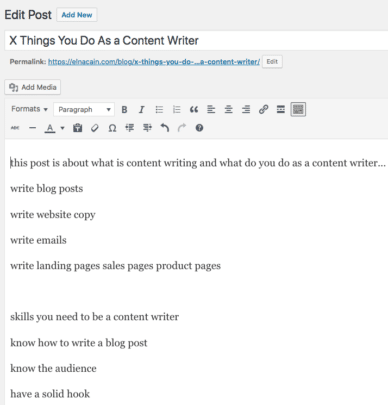
This helps me figure out the length of the blog post, how much information I need to write about and jogs my memory if I decide to work on other projects in the interim.
Each point in my outline is typically a subheading or part of a larger subheading.
3. Share Your Story
Okay – this is pretty important. It’s right up there next to your headline.
According to Neil Patel, there are over a billion blogs today.
[W]hen I first started with content marketing, there were less than 30 million blogs that existed and now there are over a billion.
Do you know what that means?
You have to stand out as a blogger. Your content needs to stand out and hook readers.
I don’t want you to feel deflated after hearing this. It is totally possible to carve a place online. I was able to do it with Twins Mommy and the niche I’m in – blogging about blogging.
This niche is highly highly over saturated, yet Twins Mommy ranks #1 for several keywords, I have an engaged email list and this blog makes money.
And that happened, because I shared my story.
I was authentic and helpful.
By sharing who you are, you start turning your blog into a brand.
And brands will outlive blogs any day of the week.
When I think of cooking, I immediately think of Minimalist Baker (brand).
If I want to learn about Pinterest marketing, I’ll go to Tailwind (brand).
And I hope for those that want to learn about freelance writing they go to Elna Cain 🙂
Creating a brand around your blog takes years, but it all starts with a story. Share your story and connect with your audience.
I know I have a lot of twin moms reading my blog posts or are in my Facebook group or on my email list.
I also know I have a lot of freelance writer moms too commenting on my posts!
Do you HAVE to be that personal on your blog? Not necessarily.
Smart Mom Ideas is another blog I own, and I don’t have an email list or products on that blog.
But, I occasionally share my story.
This builds trust with my Smart Mom Ideas audience.
So, as a blogger, find a way to share your story – with your About Me page, blog voice, or emails – as a way to help serve your audience better.
4. Pay Attention to Your Audience
When using your blog post template, pay attention to your audience.
When you do this one thing, you suddenly turn a blog-centric post to a reader-centric post.
You are talking to your audience when you write your blog post. Sure you can use “I” when sharing your story or talking about you, but try to make most of your blog post about your readers.
Blogging for money isn’t a personal diary account. But, it can incorporate YOUR strategies and tips to help others in your niche.
An easy way to pay attention to your audience is to incorporate them in your headline.
Remember my headline examples? 107 Toddler Activities That Take Moms Minutes to Set Up
I call out “moms with toddlers” in that headline.
This immediately makes me focus on moms with toddlers when I write that blog post idea.
5. Remove Distractions
To write a blog post, you need your full attention. No multi-tasking and no interruptions from life.
Now, as a mom – stay at home mom – this is a huge tall order to accomplish.
My husband also works from home and we constantly “bug” each other with our text messages.
And I can never write a blog post when my twins are home. Before they went to school, I only wrote when the house was quite (nap times or bedtime).
For me, to minimize distractions, I listen to music when I write to boost my productivity and creativity.
Over the years it’s changed – from modern classical music to listening to JLo or Ariana Grande.
So, if possible, listen to music while writing. Over time you will pair music with writing and it will help you “get in the zone.”
6. Practice Typing
I wasn’t a very fast typer when I first starting blogging.
I had to practice by typing every day and by taking typing tests.
Remember, as a freelance writer, it is a good idea to be able to adeptly and swiftly type so that you can make more money (i.e. write 3 blog posts a day rather than 2).
When you can adeptly type, you won’t make as many spelling mistakes and you can write up that blog post when your little one naps for 45 minutes!
Use a Blog Post Template to Write Amazing Posts
There ya go!
Some proven and actionable tips to help you write an amazing blog post. Remember, it’s okay to start with only one blog post when you launch.
I did this for all of my blogs and look where they are now!
Take time improving your blog writing, sharing your blogging voice and you will attract an engaging audience that wants to learn from you!
Over to you – what’s the one thing you know you need to improve to write a better blog post?
For me, it’s not being too wordy! 🙂
Please remember to share this!

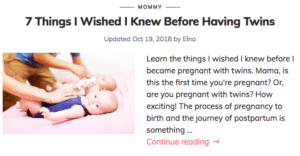
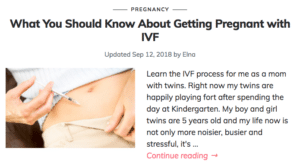
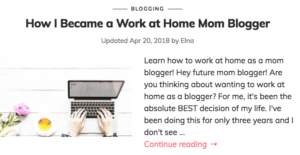



20 Comments